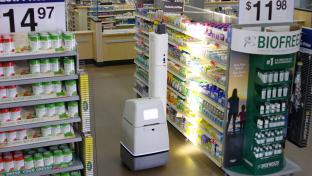7 Reasons Grocers Should Invest in Robotics Right Now
The so-called “six-foot economy” — named for the practice that keeps shoppers socially distant to prevent infection — is here for the foreseeable future, and food retailers are working double-time to maintain business as usual during these highly unusual times.
The COVID-19 pandemic has added a significant layer of operational complexity to already existing industry-wide challenges. Expectations of cleanliness are at an all-time high among shoppers. With significant inventory turnover, it’s a struggle to keep shelves consistently stocked. Added to retail’s long-standing labor shortage, it’s no wonder this new reality is causing a growing number of grocers and other retailers to evaluate how automation and robots can bring greater efficiency, flexibility, and sanitation to their in-store operations.
Enter the latest wave of autonomous mobile robots (AMRs) — intelligent machines that can safely navigate crowded public spaces while taking care of mission-critical tasks. From robotic floor scrubbers and vacuum sweepers to self-driving shelf scanners and in-store delivery tugs, AMRs can be deployed quickly and easily, require no costly or complicated infrastructure, and show too much value for grocers to ignore. Many top U.S. retailers, including Walmart, Kroger, and Giant Eagle, have already made the leap and are seeing huge dividends.
Why is Now the Time for Grocers to Invest in Autonomous Robots?
Every food retail business today should be assessing the value of robotics as a part of its retail operations. Why? Here are seven reasons:
- Cleaning has never been more important: It’s now more vital than ever that food retailers implement heightened cleaning and sanitizing so shoppers and employees are safe. Autonomous floor scrubbers and vacuums clean hard floors and carpeted surfaces methodically and consistently. They also free up staff to focus on other important cleaning tasks that robots can’t handle, like sanitizing door knobs, credit card readers, shopping carts, and other high-contact surfaces. Cleaning robots powered by Brain Corp’s software currently deliver more than 10,000 hours of daily work at retail locations, according to network data. That time is returned to employees.
- Verifiable performance metrics: Retail staff can easily become side-tracked by last-minute restocking needs, urgent clean-ups, and customers. AMRs ensure that important tasks get done and provide operational and performance data in near real-time. The information they capture is uploaded to the cloud and compiled into graphical dashboards and email reports so that managers and operational leaders have the insights they need to drive decision-making and prove ROI.
- More timely and accurate inventory insights: A lack of timely visibility into product pricing and inventory availability can easily lead to a decline in sales. In fact, out-of-stock and overstocked inventory costs retailers nearly $1 trillion in lost revenue globally, according to the IHL Group. Manually tracking inventory is time-sensitive, tedious, and prone to human error. Autonomous shelf-scanners, on the other hand, bring greater accuracy, consistency, and speed to data collection, which enables more efficient inventory management, improved sales, and enhanced customer experience.
- Keeping shelves sufficiently stocked: Retail staff regularly move heavy loads of inventory from storage to shelves throughout the day. While a human worker can only pull 350-500 lbs worth of stock per trip, autonomous inventory delivery units can move up to 1,000 lbs each trip using a variety of common cart types. Delegating this laborious and time-consuming work to robots not only frees up staff for other key tasks, but also enables faster point-to-point delivery, increasing on-shelf availability and improving sales.
- Reducing exposure to workers’ comp claims: Operating large manual machines like floor scrubbers and hauling heavy stock carts full of inventory puts a literal strain on employees. In fact, according to the U.S. Bureau of Labor Statistics, there were 42,790 retail employee injuries in 2018 due to overexertion. These on-the-job injuries are costly to employees and businesses alike. By automating physically demanding activities, businesses can minimize employee injuries and create a safer retail environment.
- Supporting over-extended employees: Adding to the risk of physical injury are the increased demands on retail employees caused by COVID-19. Employees must constantly multitask to keep up with ever-shifting priorities and the stress of making sure shoppers follow best practices (like staying six feet apart). By automating time-intensive tasks like cleaning floors, checking stock, and moving inventory, store managers can narrow their staff’s scope of work to reduce their overall burden and focus on other higher value responsibilities.
- Maintaining a positive brand image: Shoppers will soon see a sharp difference between grocers that do invest in robotics and automation and those that don’t. Consumer perceptions will be hard to shake if competitors are running cleaner, more efficient, better stocked, and more hospitable retail operations. AMRs, specifically those that clean, send a clear message to shoppers that a retailer is invested in their safety and wellbeing.
As the world adjusts to the new normal, food retailers must prepare for the next normal. Investing in a long-term robotics strategy to bring greater efficiency, safety, accountability, and cost management to in-store operations is one of the first steps. While AMRs are not a panacea for all of the challenges grocers face, they do address the most critical ones: labor shortages, employee safety, consumer experience, and sanitation.







